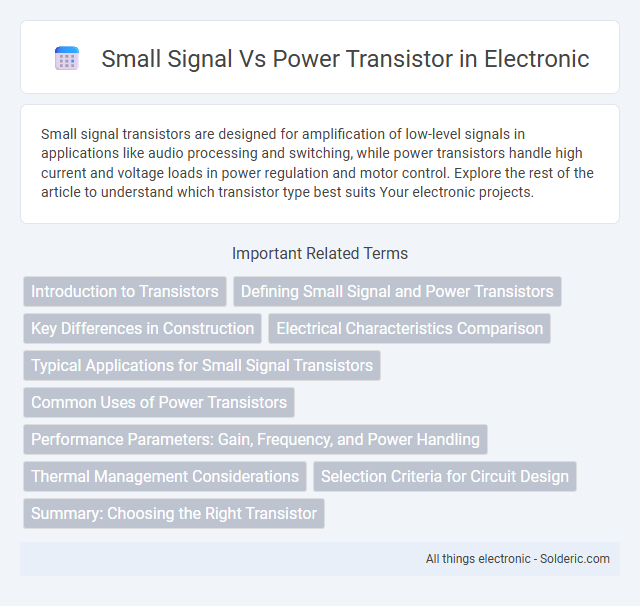Small signal transistors are designed for amplification of low-level signals in applications like audio processing and switching, while power transistors handle high current and voltage loads in power regulation and motor control. Explore the rest of the article to understand which transistor type best suits Your electronic projects.
Comparison Table
| Feature | Small Signal Transistor | Power Transistor |
|---|---|---|
| Purpose | Amplify low-level signals | Switch or amplify high-current, high-power signals |
| Current Rating | Typically below 100mA | Can handle from a few amps to tens of amps |
| Voltage Rating | Usually below 50V | Up to several hundred volts |
| Power Dissipation | Low (milliwatts to a few watts) | High (tens to hundreds of watts) |
| Package Size | Small | Large with heat sinks |
| Frequency Response | High (up to GHz range) | Lower, optimized for power rather than speed |
| Applications | Signal amplification, switching in low current circuits | Power supplies, motor control, audio amplification |
Introduction to Transistors
Small signal transistors are designed for low current and voltage applications, typically used in amplification and switching of weak electrical signals. Power transistors handle higher current and voltage levels, making them suitable for driving loads such as motors or power supplies. Both types rely on semiconductor materials like silicon to control electrical power flow, but their construction and ratings differ to optimize performance for their specific roles.
Defining Small Signal and Power Transistors
Small signal transistors are designed for low current and voltage applications, typically used in amplification of weak electrical signals within circuits operating at frequencies up to several hundred megahertz. Power transistors handle higher current and voltage levels, enabling control and amplification in power electronics, such as motor drives and power supplies, often dissipating significant heat. These two types differ primarily in their maximum collector current, voltage ratings, and packaging designed to optimize thermal management and switching speed.
Key Differences in Construction
Small signal transistors feature thin semiconductor layers and low current handling capacity designed for amplification of weak signals, whereas power transistors have thicker semiconductor layers, larger junctions, and enhanced heat dissipation mechanisms to manage high current and voltage loads. The construction of power transistors includes robust packaging and often integrated heat sinks to withstand thermal stress, unlike the compact and lightweight design of small signal transistors optimized for high-frequency switching. These design differences directly impact their electrical characteristics, such as gain, switching speed, and maximum power dissipation.
Electrical Characteristics Comparison
Small signal transistors are designed for amplification and switching of low current and voltage signals, typically handling currents up to a few hundred milliamps and voltages under 100V, with high gain and low noise characteristics. Power transistors, on the other hand, are engineered to manage high currents (several amperes) and higher voltages (often exceeding 100V), featuring lower gain but higher current capacity, thermal stability, and ruggedness to handle significant power dissipation. Their electrical characteristics differ primarily in current rating, voltage tolerance, gain bandwidth product, and thermal resistance, reflecting their distinct applications in low-level signal processing versus high-power control circuits.
Typical Applications for Small Signal Transistors
Small signal transistors are primarily used in applications requiring low current and voltage amplification, such as in audio signal processing, switching circuits, and radio frequency (RF) amplification. They excel in tasks like signal modulation, sensor interfacing, and logic gates due to their high gain and fast switching capabilities. Your electronic designs benefit from their ability to handle small currents efficiently without significant power dissipation.
Common Uses of Power Transistors
Power transistors are commonly used in applications requiring high current and voltage handling, such as audio amplifiers, switching power supplies, motor control circuits, and voltage regulators. Unlike small signal transistors designed for low-power signal amplification, power transistors efficiently control and switch large amounts of electrical energy, making them essential in industrial equipment and consumer electronics. Your choice of a power transistor ensures reliable performance in heavy-duty and high-power electronic devices.
Performance Parameters: Gain, Frequency, and Power Handling
Small signal transistors excel in high gain and frequency response, often operating efficiently up to GHz ranges but are limited in power handling, typically under a few watts. Power transistors prioritize high power handling capabilities, managing tens to hundreds of watts, but generally exhibit lower gain and reduced frequency performance compared to small signal devices. The choice between these transistors depends on balancing gain, frequency requirements, and power dissipation for optimized circuit performance.
Thermal Management Considerations
Small signal transistors typically dissipate low power, requiring minimal thermal management with small heat sinks or natural convection cooling. Power transistors handle high currents and voltages, generating significant heat that necessitates robust thermal solutions such as large heat sinks, forced air cooling, or liquid cooling to prevent thermal runaway. Effective thermal management in power transistors involves optimizing junction-to-case thermal resistance and ensuring efficient heat transfer to maintain device reliability and performance.
Selection Criteria for Circuit Design
Small signal transistors are ideal for low-current, high-frequency circuits requiring amplification of weak signals, while power transistors handle higher currents and dissipate more heat, making them suitable for driving loads or power regulation. Selection criteria include current gain, voltage rating, power dissipation, switching speed, and thermal management capabilities to ensure reliable operation within your circuit's requirements. Choosing the right transistor type optimizes performance, efficiency, and longevity of your electronic design.
Summary: Choosing the Right Transistor
Small signal transistors are designed for low-current, low-voltage applications such as amplification of weak signals in radios or sensors, focusing on high gain and frequency response. Power transistors handle high current and voltage, used in power regulation, motor control, and switching applications, emphasizing heat dissipation and robustness. Selecting the right transistor depends on the application's voltage, current, frequency requirements, and thermal management needs.
Small signal vs Power transistor Infographic

 solderic.com
solderic.com